House of Representatives of the Philippines
The House of Representatives of the Philippines (Filipino: Kapulungan ng mga Kinatawan ng Pilipinas, Spanish: Cámara de Representantes de Filipinas) is the lower house of the Congress of the Philippines. It is commonly referred to as Congress and informally referred to as the Cámara or Kamara.
House of Representatives of the Philippines Kapulungan ng mga Kinatawan ng Pilipinas Cámara de Representantes de Filipinas | |
|---|---|
| 18th Congress of the Philippines | |
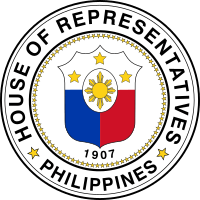 Seal of the House of Representatives | |
 Flag of the House of Representatives | |
| Type | |
| Type | |
Term limits | 3 consecutive terms (9 years) |
| Leadership | |
| |
| Structure | |
| Seats | 304 representatives 243 from congressional districts 61 party-list representatives |
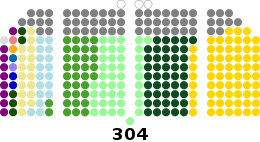 | |
Political groups | Majority bloc (270)
Minority bloc (30)
Independent minority bloc (2)
Vacancy (3)
|
| Committees | 58 standing committees and 14 special committees |
Length of term | 3 years |
| Authority | Article VI, Constitution of the Philippines |
| Elections | |
| Parallel voting | |
Last election | May 13, 2019 |
Next election | 2022 |
| Redistricting | Districts are redistricted by Congress after each census (has never been done since 1987) By statute (most frequent method) |
| Meeting place | |
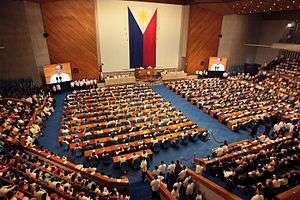 | |
| Batasang Pambansa Complex Batasan Hills, Quezon City, Philippines | |
| Website | |
| House of Representatives of the Philippines | |
Members of the House are officially styled as representative (Kinatawan) and sometimes informally called Congressmen or Congresswomen (mga kongresista) and are elected to a three-year term. They can be re-elected, but cannot serve more than three consecutive terms. Around eighty percent of congressmen are district representatives, representing a particular geographical area. The 18th Congress has 243[1] legislative districts, each composed of about 250,000 people. There are also party-list representatives elected through the party-list system who constitute not more than twenty percent of the total number of representatives.
Aside from needing its agreement to every bill in order to be sent for the President's signature to become law, the House of Representatives has power to impeach certain officials and all money bills must originate from the lower house.
The House of Representatives is headed by the Speaker, currently Alan Peter Cayetano of Taguig-Pateros (Nacionalista Party). The Speaker of the House is the third in the presidential line of succession, after the Vice President and Senate President. The official headquarters of the House of Representatives is at the Batasang Pambansa (lit. 'national legislature') located in the Batasan Hills in Quezon City in Metro Manila. The building is often simply called Batasan and the word has also become a metonym to refer to the House of Representatives.
History
 |
|---|
| This article is part of a series on the politics and government of the Philippines |
|
|
|
Constitutional commissions |
|
Related topics |
|
|
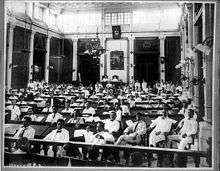
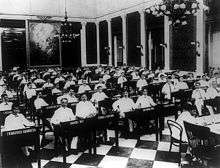

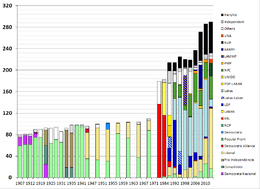
Philippine Assembly
At the beginning of American colonial rule, from March 16, 1900, the sole national legislative body was the Philippine Commission with all members appointed by the President of the United States. Headed by the Governor-General of the Philippines the body exercised all legislative authority given to it by the President and the United States Congress until October 1907 when it was joined by the Philippine Assembly. William Howard Taft was chosen to be the first American civilian Governor-General and the first leader of this Philippine Commission, which subsequently became known as the Taft Commission.
The Philippine Bill of 1902, a basic law, or organic act, of the Insular Government, mandated that once certain conditions were met a bicameral, or two-chamber, Philippine Legislature would be created with the previously existing, all-appointed Philippine Commission as the upper house and the Philippine Assembly as the lower house. This bicameral legislature was inaugurated in October 1907. Under the leadership of Speaker Sergio Osmeña and Floor Leader Manuel L. Quezon, the Rules of the 59th United States Congress was substantially adopted as the Rules of the Philippine Legislature. Osmeña and Quezon led the Nacionalista Party, with a platform of independence from the United States, into successive electoral victories against the Progresista Party and later the Democrata Party, which first advocated United States statehood, then opposed immediate independence.
It is this body, founded as the Philippine Assembly, that would continue in one form or another, and with a few different names, up until the present day.
Jones Act of 1916
In 1916, the Jones Act, officially the Philippine Autonomy Act, changed the legislative system. The Philippine Commission was abolished and a new fully elected, bicameral Philippine Legislature consisting of a House of Representatives and a Senate was established. The Nacionalistas continued their electoral dominance at this point, although they were split into two factions led by Osmeña and Quezon; the two reconciled in 1924, and controlled the Assembly via a virtual dominant-party system.
Commonwealth and the Third Republic
The legislative system was changed again in 1935. The 1935 Constitution established a unicameral National Assembly. But in 1940, through an amendment to the 1935 Constitution, a bicameral Congress of the Philippines consisting of a House of Representatives and a Senate was adopted.
Upon the inauguration of the Republic of the Philippines in 1946, Republic Act No. 6 was enacted providing that on the date of the proclamation of the Republic of the Philippines, the existing Congress would be known as the First Congress of the Republic. The "Liberal bloc" of the Nacionalistas permanently split from their ranks, creating the Liberal Party. These two will contest all of the elections in what appeared to be a two-party system. The party of the ruling president wins the elections in the House of Representatives; in cases where the party of the president and the majority of the members of the House of Representatives are different, a sufficient enough number will break away and join the party of the president, thereby ensuring that the president will have control of the House of Representatives.
Martial Law
This set up continued until President Ferdinand Marcos declared martial law and abolished Congress. He would rule by decree even after the 1973 Constitution abolished the bicameral Congress and created a unicameral Batasang Pambansa parliamentary system of government, as parliamentary election would not occur in 1978. Marcos' Kilusang Bagong Lipunan (KBL; New Society Movement) won all of the seats except those from the Central Visayas ushering in an era of KBL dominance, which will continue until the People Power Revolution overthrew Marcos in 1986.
1987 Constitution
The 1987 Constitution restored the presidential system of government together with a bicameral Congress of the Philippines. One deviation from the previous setup was the introduction of the mid-term election; however, the dynamics of the House of Representatives resumed its pre-1972 state, with the party of the president controlling the chamber, although political pluralism ensued that prevented the restoration of the old Nacionalista-Liberal two-party system. Instead, a multi-party system evolved.
Corazon Aquino who nominally had no party, supported the Laban ng Demokratikong Pilipino (LDP; Struggle of the Democratic Filipinos). With the victory of Fidel V. Ramos in the 1992 presidential election, many representatives defected to his Lakas-NUCD party; the same would happen with Joseph Estrada's victory in 1998, but he lost support when he was ousted after the 2001 EDSA Revolution that brought his vice president Gloria Macapagal-Arroyo to power. This also meant the restoration of Lakas-NUCD as the top party in the chamber. The same would happen when Benigno Aquino won in 2010, which returned the Liberals into power.
The presiding officer is the Speaker. Unlike the Senate President, the Speaker usually serves the entire term of Congress, although there had been instances when the Speaker left office due to conflict with the president: examples include Jose de Venecia Jr.'s resignation as speaker in 2008 when his son Joey de Venecia exposed alleged corrupt practices by First Gentleman Mike Arroyo, and Manny Villar's ouster occurred after he allowed the impeachment of President Estrada in 2000.
Officers
The members of the House of Representatives who are also its officers are also ex officio members of all of the committees and have a vote.
Speaker
The Speaker is the head of the House of Representatives. He presides over the session; decides on all questions of order, subject to appeal by any member; signs all acts, resolutions, memorials, writs, warrants and subpoenas issued by or upon order of the House; appoints, suspends, dismisses or disciplines House personnel; and exercise administrative functions.
The speaker is elected by majority of all the members of the house, including vacant seats. The speaker is traditionally elected at the convening of each Congress. Before a speaker is elected, the House's sergeant-at-arms sits as the "Presiding Officer" until a speaker is elected. Compared to the Senate President, the unseating of an incumbent speaker is rarer.
As of July 2019, the incumbent speaker is Alan Peter Cayetano (Nacionalista Party) of Taguig City-Pateros.
Deputy Speakers
There was a position of speaker pro tempore for congresses prior the reorganization of the officers of the House of Representatives during the 10th Congress in 1995. The speaker pro tempore was the next highest position in the House after the speaker.
The position was replaced by deputy speakers in 1995. Originally, there was one Deputy Speaker for each island group of Luzon, Visayas and Mindanao. Then, in 2001 during the 12th Congress, a Deputy Speaker "at large" was created. In the next Congress, another "at large" deputy speakership was created, along with a Deputy Speaker for women. In the 15th Congress starting in 2010, all six deputy speakers are "at large".
The deputy speakers perform the speaker's role when the speaker is absent. Currently in the 16th Congress, the deputy speakers represent the chamber at-large.
The Deputy Speakers are:
- Paolo Duterte (Davao City–1st, Hugpong ng Pagbabago)
- Ferdinand L. Hernandez (South Cotabato–2nd, Nationalist People's Coalition)
- Evelina G. Escudero (Sorsogon–1st, Nationalist People's Coalition)
- Loren Legarda (Antique–Lone, Nationalist People's Coalition)
- Conrado Estrella III (ABONO Partylist)
- Prospero Pichay Jr. (Surigao del Sur–1st, Lakas–CMD)
- Roberto Puno (Antipolo–1st, National Unity Party)
- Eduardo Villanueva (CIBAC Partylist)
- Aurelio D. Gonzales Jr. (Pampanga–3rd, PDP-Laban)
- Johnny Pimentel (Surigao del Sur–2nd, PDP-Laban)
- Luis Raymund Villafuerte Jr. (Camarines Sur–2nd, Nacionalista)
Elected last July 22, 2019
Majority Floor Leader
The majority leader, aside from being the spokesman of the majority party, is to direct the deliberations on the floor. The Majority Leader is also concurrently the Chairman of the Committee on Rules. The majority leader is elected in a party caucus of the ruling majority party.
The incumbent majority floor leader is Ferdinand Martin G. Romualdez (Lakas-CMD) of Leyte's First district.
Minority Floor Leader
The minority leader is the spokesman of the minority party in the House and is an ex-officio member of all standing Committees. The minority leader is elected in party caucus of all Members of the House in the minority party, although by tradition, the losing candidate for speaker is named the minority leader.
The incumbent minority floor leader is Bienvinido M. Abante Jr. (Asenso Manileño) of Manila's 6th District.
Secretary General
The secretary general enforces orders and decisions of the House; keeps the Journal of each session; notes all questions of order, among other things. The secretary general presides over the chamber at the first legislative session after an election, and is elected by a majority of the members.
As of July 22, 2019, Atty. Jose Luis Montales is the Secretary General of the House of Representatives.
Sergeant-at-Arms
The Sergeant-at-Arms is responsible for the maintenance of order in the House of Representatives, among other things. Like the Secretary General, the Sergeant-at-Arms is elected by a majority of the members.
As of July 22, 2019, Retired Police Deputy Director General Ramon Apolinario is the Sergeant-at-Arms of the House of Representatives.
Membership
There are two types of congressmen: those who represent geographic districts, and those who represent party-lists. The first-past-the-post (simple plurality voting) method is used to determine who represents each of the 243 geographic districts. The party-list representatives are elected via the party-list system. The party-list representatives should always comprise 20% of the seats.
Originally set at 200 in the ordinance of the constitution, the number of districts has grown to 243. All of the new districts are via created via piecemeal redistricting of the then existing 200 districts, and via the creation of new provinces and cities. The constitution gave Congress to nationally redistrict the country after the release of every census, but this has not been done.
The original 200 districts meant that there should have been 50 party-list representatives. However, the constitution did not give the specifics on how party-list congressmen should have been elected. This led to presidents appointing sectoral representatives, which were then approved by the Commission on Appointments; only a handful of sectoral representatives were seated in this way. The first party-list election was in 1998; with the 2% election threshold, a 3-seat cap and tens of parties participating, this led to only about a fraction of the party-list seats being distributed. Eventually, there had been several Supreme Court decisions changing the way the winning seats are distributed, ensuring that all party-list seats are filled up.
As there are 243 congressional districts, there are 60 party-list representatives, for a total of 303 congressmen.
District representation
Eighty percent of representatives shall come from congressional districts, with each district returning one representative. Although each district should have a population of at least 250,000 people, all provinces have at least one legislative district, regardless of population, whose residents vote for their own congressman; several cities have representation of their own, independent of provinces, although they should have at least a population of 250,000. For provinces that have more than one legislative district, the provincial districts are identical to the corresponding legislative district, with the exclusion of cities that do not vote for provincial officials.
The representatives from the districts comprise at most 80% of the members of the House; therefore, for a party to have a majority of seats in the House, the party needs to win at least 60% of the district seats. No party since the approval of the 1987 constitution has been able to win a majority of seats, hence coalitions are not uncommon.
Legislative districts in provinces
- Abra (1)
- Agusan del Norte (2)[lower-alpha 1]
- Agusan del Sur (2)
- Aklan (2)
- Albay (3)
- Antique (1)
- Apayao (1)
- Aurora (1)
- Basilan (1)
- Bataan (2)
- Batanes (1)
- Batangas (6)[lower-alpha 2]
- Benguet (1)
- Biliran (1)
- Bohol (3)
- Bukidnon (4)
- Bulacan (4)[lower-alpha 3]
- Cagayan (3)
- Camarines Norte (2)
- Camarines Sur (5)[lower-alpha 4]
- Camiguin (1)
- Capiz (2)
- Catanduanes (1)
- Cavite (8)[lower-alpha 5]
- Cebu (7)[lower-alpha 6]
- Cotabato (3)
- Davao de Oro (2)
- Davao del Norte (2)
- Davao Occidental (1)
- Davao Oriental (2)
- Davao del Sur (1)
- Dinagat Islands (1)
- Eastern Samar (1)
- Guimaras (1)
- Ifugao (1)
- Ilocos Norte (2)
- Ilocos Sur (2)
- Iloilo (5)
- Isabela (6)[lower-alpha 7]
- Kalinga (1)
- La Union (2)
- Laguna (4)[lower-alpha 8]
- Lanao del Norte (2)
- Lanao del Sur (2)
- Leyte (5)[lower-alpha 9]
- Maguindanao (2)[lower-alpha 10]
- Marinduque (1)
- Masbate (3)
- Misamis Occidental (2)
- Misamis Oriental (2)
- Mountain Province (1)
- Negros Occidental (6)
- Negros Oriental (3)
- Northern Samar (2)
- Nueva Ecija (4)
- Nueva Vizcaya (1)
- Occidental Mindoro (1)
- Oriental Mindoro (2)
- Palawan (3)[lower-alpha 11]
- Pampanga (4)[lower-alpha 12]
- Pangasinan (6)[lower-alpha 13]
- Quezon (4)[lower-alpha 14]
- Quirino (1)
- Rizal (2)[lower-alpha 15]
- Romblon (1)
- Samar (2)
- Sarangani (1)
- Siquijor (1)
- Sorsogon (2)
- South Cotabato (2)[lower-alpha 16]
- Southern Leyte (1)
- Sultan Kudarat (2)
- Sulu (2)
- Surigao del Norte (2)
- Surigao del Sur (2)
- Tarlac (3)
- Tawi-Tawi (1)
- Zambales (2)[lower-alpha 17]
- Zamboanga del Norte (3)
- Zamboanga del Sur (2)
- Zamboanga Sibugay (2)
Notes
- The independent city of Butuan remains part of Agusan del Norte's congressional representation.
- The component cities of Batangas and Lipa are officially known as the 5th and 6th Districts of Batangas, respectively.
- The component city of San Jose del Monte is represented separately from Bulacan, but remains as part of the province's 1st District for the purpose of electing Sangguniang Panlalawigan members.
- The independent city of Naga remains part of Camarines Sur's congressional representation.
- The component cities of Bacoor, Dasmariñas, General Trias and Imus are officially known as the 2nd, 4th, 6th and 3rd Districts of Cavite, respectively.
- The independent city of Mandaue remains part of Cebu's congressional representation until 2022.
- The independent city of Santiago remains part of Isabela's congressional representation.
- The component cities of Biñan and Calamba are represented separately from Laguna, but remains as part of the province's 1st and 2nd Districts, respectively, for the purpose of electing Sangguniang Panlalawigan members. The component city of Santa Rosa will be represented separately from Laguna starting 2022, but will remain part of the province's 1st SP district.
- The independent cities of Ormoc and Tacloban remain part of Leyte's congressional representation.
- The independent city of Cotabato remains part of Maguindanao's congressional representation.
- The independent city of Puerto Princesa remains part of Palawan's congressional representation.
- The independent city of Angeles remains part of Pampanga's congressional representation.
- The independent city of Dagupan remains part of Pangasinan's congressional representation.
- The independent city of Lucena remains part of Quezon's congressional representation.
- The component city of Antipolo is represented separately from Rizal, but returns one member from each of its districts to the province's Sangguniang Panlalawigan.
- The independent city of General Santos remains part of South Cotabato's congressional representation until 2022.
- The independent city of Olongapo remains part of Zambales's congressional representation.
Legislative districts in cities
- Antipolo (2)
- Bacolod (1)
- Baguio (1)
- Biñan (1)
- Cagayan de Oro (2)
- Calamba (1)
- Caloocan (2)
- Cebu City (2)
- Davao City (3)
- Iligan (1)
- Iloilo City (1)
- Lapu-Lapu (1)
- Las Piñas (1)
- Makati (2)
- Malabon (1)
- Mandaluyong (1)
- Manila (6)
- Marikina (2)
- Muntinlupa (1)
- Navotas (1)
- Parañaque (2)
- Pasay (1)
- Pasig (1)
- Pateros and Taguig (1)
- Quezon City (6)
- San Jose del Monte (1)
- San Juan (1)
- Taguig (1)
- Valenzuela (2)
- Zamboanga City (2)
Party-list representation
The party-list system is the name designated for party-list representation. Under the 1987 Constitution, the electorate can vote for certain party-list organizations in order to give voice to significant minorities of society that would otherwise not be adequately represented through geographical district. From 1987 to 1998, party-list representatives were appointed by the President.
Since 1998, each voter votes for a single party-list organization. Organizations that garner at least 2% of the total number of votes are awarded one representative for every 2% up to a maximum of three representatives. Thus, there can be at most 50 party-list representatives in Congress, though usually no more than 20 are elected because many organizations do not reach the required 2% minimum number of votes.
After the 2007 election, in a controversial decision, the Supreme Court ordered the COMELEC to change how it allocates the party-list seats. Under the new formula only one party will have the maximum 3 seats. It based its decision on a formula contained in the VFP vs. COMELEC decision. In 2009, in the BANAT vs. COMELEC decision, it was changed anew in which parties with less than 2% of the vote were given seats to fulfill the 20% quota as set forth in the constitution.
Aside from determining which party won and allocating the number of seats won per party, another point of contention was whether the nominees should be a member of the marginalized group they are supposed to represent; in the Ang Bagong Bayani vs. COMELEC decision, the Supreme Court not only ruled that the nominees should be a member of the marginalized sector, but it also disallowed major political parties from participating in the party-list election. However, on the BANAT decision, the court ruled hat since the law didn't specify who belongs to a marginalized sector, the court allowed anyone to be a nominee as long as the nominee as a member of the party (not necessarily the marginalized group the party is supposed to represent).
Redistricting
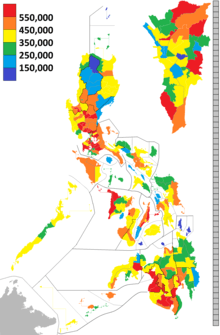
Congress is mandated to reapportion the legislative districts within three years following the return of every census.[2] Since its restoration in 1987, Congress has not passed any general apportionment law, despite the publication of six censuses in 1990, 1995, 2000, 2007, 2010 and 2015.[3] The increase in the number of representative districts since 1987 were mostly due to the creation of new provinces, cities, and piecemeal redistricting of certain provinces and cities.
The apportionment of congressional districts is not dependent upon a specially-mandated independent government body, but rather through Republic Acts which are drafted by members of Congress. Therefore, apportionment often can be influenced by political motivations. Incumbent representatives who are not permitted by law to serve after three consecutive terms sometimes resort to dividing their district, or even creating a new province which will be guaranteed a seat, just so that their allies be able to run, while "switching offices" with them. Likewise, politicians whose political fortunes are likely to be jeopardized by any change in district boundaries may delay or even ignore the need for reapportionment.
Since 1987, the creation of some new congressional districts have been met with controversy, especially due to incumbent political clans and their allies benefiting from the new district arrangements. Some of these new congressional districts are tied to the creation of a new province, because such an act necessarily entails the creation of a new congressional district.
- Creation of Davao Occidental, 2013: The rival Cagas and Bautista clans dominate politics in the province of Davao del Sur; their members have been elected as congressional representatives for the first and second districts of the province since 1987. However, the province's governorship has been in contest between the two clans in recent years: Claude Bautista, the current governor, was elected in 2013; before that Douglas Cagas served as governor from 2007 to 2013, after succeeding Benjamin Bautista Jr. who served from 2002 to 2007.[4] Supporters of both clans have been subjected to political violence, prompting the police to put the province of Davao del Sur in the election watchlist.[5] The law which created Davao Occidental, Republic Act No. 10360, was co-authored by House Representatives Marc Douglas Cagas IV and Franklin Bautista as House Bill 4451; the creation of the new province is seen as a way to halt the "often violent" political rivalry between the clans by ensuring that the Cagas and Bautista clans have separate domains.[5]
- Reapportionment of Camarines Sur, 2009: A new congressional district was created within Camarines Sur under Republic Act No. 9716, which resulted in the reduction of the population of the province's first district to below the Constitutional ideal of 250,000 inhabitants. The move was seen as a form of political accommodation that would (and ultimately did) prevent two allies of then-President Gloria Macapagal-Arroyo from running in the same district. Rolando Andaya, who was on his third term as congressman for the first district, was appointed Budget Secretary in 2006; his plans to run as representative of the same district in 2010 put him in direct competition with Diosdado Macapagal-Arroyo, the president's youngest son, who was also seeking re-election. Then-Senator Noynoy Aquino challenged the constitutionality of the law but the Supreme Court of the Philippines ultimately ruled that the creation of the new district was constitutional.[6]
- Creation of Dinagat Islands, 2007: The separation of Dinagat Islands from Surigao del Norte has further solidified the hold of the Ecleo clan over the impoverished and typhoon-prone area, which remains among the poorest provinces in the country.[7]
Most populous legislative districts
Currently the district with the lowest population is the lone district of Batanes, with only 17,246 inhabitants in 2015. The most populous congressional district, the 1st District of Caloocan City, has around 69 times more inhabitants. Data below reflect the district boundaries for the 2019 elections, and the population counts from the 2015 census.[8]
| Rank | Legislative district | Population (2015) |
|---|---|---|
| 1 | 1st District of Caloocan City | 1,193,419 |
| 2 | 2nd District of Rizal | 1,070,852 |
| 3 | 1st District of Rizal | 1,036,989 |
| 4 | 1st District of South Cotabato | 856,536 |
| 5 | 1st District of Maguindanao | 821,475 |
| 6 | 1st District of Pampanga | 775,580 |
| 7 | Lone district of Pasig City | 755,300 |
| 8 | 4th District of Bulacan | 746,699 |
| 9 | 1st District of Bulacan | 717,820 |
| 10 | 1st District of Cebu | 709,660 |
Underrepresentation
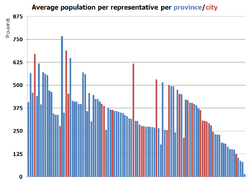

Because of the lack of a nationwide reapportionment after the publication of every census since the Constitution was promulgated in 1987, faster-growing provinces and cities have become severely underrepresented. Each legislative district is ideally supposed to encompass a population of 250,000.[9]
Powers
The House of Representatives is modeled after the United States House of Representatives; the two chambers of Congress have roughly equal powers, and every bill or resolution that has to go through both houses needs the consent of both chambers before being passed for the president's signature. Once a bill is defeated in the House of Representatives, it is lost. Once a bill is approved by the House of Representatives on third reading, the bill is passed to the Senate, unless an identical bill has also been passed by the lower house. When a counterpart bill in the Senate is different from the one passed by the House of Representatives, either a bicameral conference committee is created consisting of members from both chambers of Congress to reconcile the differences, or either chamber may instead approve the other chamber's version.
Just like most lower houses, money bills, originate in the House of Representatives, but the Senate may still propose or concur with amendments, same with bills of local application and private bills. The House of Representatives has the sole power to initiate impeachment proceedings, and may impeach an official by a vote of one-third of its members. Once an official is impeached, the Senate tries that official.
Seat
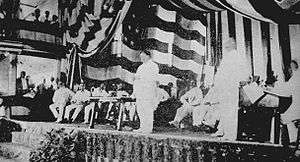

The Batasang Pambansa Complex (National Legislature) at Quezon City is the seat of the House of Representatives since its restoration in 1987; it took its name from the Batasang Pambansa, the national parliament which convened there from 1978 to 1986.
The Philippine Legislature was inaugurated at the Manila Grand Opera House at 1907, then it conducted business at the Ayuntamiento in Intramuros. Governor-General Leonard Wood summoned the 2nd Philippine Legislature at Baguio and convened at The Mansion in Baguio for three weeks. The legislature returned to the Ayutamiento, as the Legislative Building was being constructed; it first convened there on July 26, 1926. The House of Representatives continued to occupy the second floor until 1945 when the area was shelled during the Battle of Manila. The building was damaged beyond repair and Congress convened at the Old Japanese Schoolhouse at Lepanto[10] (modern-day S. H. Loyola) Street, Manila until the Legislative Building can be occupied again in 1949. Congress stayed at the Legislative Building, by now called the Congress Building, until President Marcos shut Congress and ruled by decree starting in 1972.[11]
Marcos then oversaw the construction of the new home of parliament at Quezon City, which convened in 1978. The parliament, called the Batasang Pambansa continued to sit there until the passage of the 1986 Freedom Constitution. The House of Representatives inherited the Batasang Pambansa Complex in 1987.
Batasang Pambansa Complex
The Batasang Pambansa Complex, now officially called the House of Representatives Building Complex, is at the National Government Center, Constitution Hills, Quezon City. Accessible via Commonwealth Avenue, the complex consists of four buildings. The Main Building hosts the session hall; the North and South wings, inaugurated in December 1977, are attached to it. The newest building, the Ramon Mitra, Jr. Building, was completed in 2001. It houses the Legislative Library, the Committee offices, the Reference and Research Bureau, and the Conference Rooms.[12]
Current composition
The members of the House of Representatives, aside from being grouped into political parties, are also grouped into the "majority bloc", "minority bloc" and "independents" (different from the independent in the sense that they are not affiliated into a political party). Originally, members who voted for the winning Speaker belong to the majority and members who voted for the opponent are the minority. The majority and minority bloc are to elect amongst themselves a floor leader. While members are allowed to switch blocs, they must do so in writing. Also, the bloc where they intend to transfer shall accept their application through writing. When the bloc the member ought to transfer refuses to accept the transferring member, or a member does not want to be a member of either bloc, that member becomes an independent member. A member that transfers to a new bloc forfeits one's committee chairmanships and memberships, until the bloc the member transfers to elects the member to committees.
The membership in each committee should be in proportion to the size of each bloc, with each bloc deciding who amongst them who will go to each committee, upon a motion by the floor leader concerned to the House of Representatives in plenary. The Speaker, Deputy Speakers, floor leaders, deputy floor leaders and the chairperson of the Committee on Accounts can vote in committees; the committee chairperson can only vote to break a tie.
To ensure that the representatives each get their pork barrel, most of them will join the majority bloc, or even to the president's party, as basis of patronage politics (known as the Padrino System locally); thus, the House of Representatives always aligns itself with the party of the sitting president.
The majority bloc sits at the right side of the speaker, facing the House of Representatives.
|
| ||||||||||||||||||||||||||||||||||||||||||||||||||||||||||||||||||||||||||||||||||||||||||||||||||||||||||||||||||||||||||||||||||||||||||||||||||||||||||||||||||||||||||||||||||||||||||||||||||||||||||||||||||||||||||||||||||||||||||||||||||||||||||||||||||||||||||||||||||||||||||||||||||||||||||||||
Latest election
 | ||||||||||||||
| Party | Popular vote | Seats | ||||||||||||
|---|---|---|---|---|---|---|---|---|---|---|---|---|---|---|
| Total | % | Swing | Entered | Up | Won[14] | % | +/− | |||||||
| PDP–Laban (Philippine Democratic Party–People's Power) | 12,653,960 | 31.23% | 127 | 94 | 82 | 26.97% | ||||||||
| Nacionalista (Nationalist Party) | 6,524,100 | 16.10% | 69 | 37 | 42 | 13.82% | ||||||||
| NPC (Nationalist People's Coalition) | 5,797,543 | 14.31% | 61 | 33 | 37 | 12.17% | ||||||||
| NUP (National Unity Party) | 3,852,909 | 9.51% | 42 | 28 | 25 | 8.22% | ||||||||
| Liberal (Liberal Party) | 2,321,759 | 5.73% | 26 | 18 | 18 | 5.92% | ||||||||
| Lakas (People Power–Christian Muslim Democrats) | 2,069,871 | 5.11% | 29 | 5 | 12 | 3.95% | ||||||||
| PFP (Federal Party of the Philippines) | 965,048 | 2.38% | 32 | 2 | 5 | 1.64% | ||||||||
| HNP (Faction of Change) | 652,318 | 1.61% | 6 | 3 | 3 | 0.99% | ||||||||
| Aksyon (Democratic Action) | 398,616 | 0.98% | 6 | 0 | 1 | 0.33% | ||||||||
| PMP (Force of the Filipino Masses) | 396,614 | 0.98% | 9 | 1 | 1 | 0.33% | ||||||||
| Bukidnon Paglaum (Hope for Bukidnon) | 335,628 | 0.83% | 3 | 2 | 2 | 0.66% | ||||||||
| PDDS (Noble Blood Association of Federalists) | 259,423 | 0.64% | 31 | 0 | 0 | 0.00% | ||||||||
| LDP (Struggle of Democratic Filipinos) | 252,806 | 0.62% | 3 | 3 | 2 | 0.66% | ||||||||
| UNA (United Nationalist Alliance) | 232,657 | 0.57% | 7 | 0 | 0 | 0.00% | ||||||||
| HTL (Party of the People of the City) | 197,024 | 0.49% | 1 | 0 | 1 | 0.33% | ||||||||
| PPP (Palawan's Party of Change) | 185,810 | 0.46% | 2 | 0 | 2 | 0.66% | ||||||||
| Bileg (Ilocano Power) | 158,523 | 0.39% | 1 | 1 | 1 | 0.33% | ||||||||
| PRP (People's Reform Party) | 138,014 | 0.34% | 2 | 0 | 1 | 0.33% | ||||||||
| Unang Sigaw (First Cry of Nueva Ecija) | 120,674 | 0.30% | 1 | 0 | 0 | 0.00% | ||||||||
| KDP (Union of Democratic Filipinos) | 116,453 | 0.29% | 4 | 0 | 0 | 0.00% | ||||||||
| Asenso Abrenio (Progress for Abrenians) | 115,865 | 0.29% | 1 | 0 | 1 | 0.33% | ||||||||
| Kambilan (Shield and Fellowship of Kapampangans) | 107,078 | 0.26% | 1 | 0 | 0 | 0.00% | ||||||||
| Padayon Pilipino (Onward Filipinos) | 98,450 | 0.24% | 2 | 0 | 0 | 0.00% | ||||||||
| Asenso Manileño (Progress for Manilans) | 84,656 | 0.21% | 2 | 0 | 2 | 0.66% | ||||||||
| Kusog Bicolandia (Force of Bicol) | 82,832 | 0.20% | 2 | 0 | 0 | 0.00% | ||||||||
| CDP (Centrist Democratic Party of the Philippines) | 81,741 | 0.20% | 1 | 0 | 1 | 0.33% | ||||||||
| Navoteño (Navotas Party) | 80,265 | 0.20% | 1 | 1 | 1 | 0.33% | ||||||||
| KABAKA (Partner of the Nation for Progress) | 65,836 | 0.16% | 1 | 1 | 1 | 0.33% | ||||||||
| PDSP (Philippine Social Democratic Party) | 56,223 | 0.14% | 3 | 0 | 0 | 0.00% | ||||||||
| Bagumbayan (New Nation-Volunteers for a New Philippines) | 33,731 | 0.08% | 1 | 0 | 0 | 0.00% | ||||||||
| KBL (New Society Movement) | 33,594 | 0.08% | 1 | 0 | 0 | 0.00% | ||||||||
| AZAP (Forward Zamboanga Party) | 28,605 | 0.07% | 1 | 0 | 0 | 0.00% | ||||||||
| WPP (Labor Party Philippines) | 9,718 | 0.02% | 2 | 0 | 0 | 0.00% | ||||||||
| DPP (Democratic Party of the Philippines) | 1,110 | 0.00% | 1 | 0 | 0 | 0.00% | ||||||||
| HSS (Surigao Sur Party) | 816 | 0.00% | 1 | 0 | 0 | 0.00% | ||||||||
| PGRP (Philippine Green Republican Party) | 701 | 0.00% | 1 | 0 | 0 | 0.00% | ||||||||
| Independent | 2,014,211 | 4.97% | 143 | 1 | 2 | 0.66% | ||||||||
| TotalA | 40,524,366 | 100% | N/A | 627 | 238 | 243 | 79.9% | |||||||
| Valid votes | 40,524,366 | 86.90% | ||||||||||||
| Invalid votes | 6,106,908 | 13.10% | ||||||||||||
| Turnout | 46,631,274 | 75.40% | ||||||||||||
| Registered voters (without overseas voters) | 61,843,771 | 100% | ||||||||||||
Notes:
^ The congressional districts for General Santos and both Southern Leyte's districts were supposedly done later in 2019, as these were approved after the ballots were printed. Elections for South Cotabato as two districts, where General Santos is included in the 1st district, and Southern Leyte's lone district, still proceeded, but all votes were declared as stray. However, the Supreme Court ruled that the result of the election for South Cotabato's 1st district, stood, ordering the commission to proclaim Shirlyn L. Bañas-Nograles as the winner.[15] The commission then decided that the winner in Southern Leyte's congressional election, Roger Mercado, be proclaimed as well.[16]
See also
- List of Philippine House committees
- 2007 Batasang Pambansa bombing
- Politics of the Philippines
- President of the Philippines
- Executive Departments of the Philippines
- Congress of the Philippines
- Senate of the Philippines
- Ombudsman of the Philippines
- Supreme Court of the Philippines
- Republic Acts of the Philippines
- Batasang Pambansa
Notes
References
- "HOUSE MEMBERS by REGION". Congress of the Philippines - House of Representatives. Retrieved November 6, 2019.
- Chan-Robles Virtual Law Library. "The 1987 Constitution of the Republic of the Philippines – Article VI". Retrieved July 25, 2008.
- National Statistical Coordination Board. "NSCB – Statistics – Population and Housing". Archived from the original on July 4, 2012. Retrieved July 25, 2008.
- Davao Occidental: Mindanao's 27th Province. Retrieved March 10, 2015.
- New Davao province has to wait. Retrieved March 10, 2015.
- Noynoy asks SC to strike down law on new CamSur district. Retrieved March 10, 2015.
- Dinagat: The hands that heal hold power. Retrieved March 10, 2015.
- "Population Counts by Legislative District (Based on the 2015 Census of Population)". Philippine Statistics Authority. July 16, 2016. Retrieved December 1, 2016.
- "RP pop'n calls for 350 Congress seats". Retrieved November 6, 2010.
- Quezon Memorial Book. Quezon Memorial Committee. 1952.
- "The Official Buildings of the House of Representatives: The Ancestral Quarters". Congress.gov.ph. Retrieved May 26, 2011.
- "The Official Buildings of the House of Representatives: The Present Legislative Building". Congress.gov.ph. Retrieved May 26, 2011.
- Commission on Elections
- "Number of Elected Candidates by Party Affiliation Per Elective Position, by Sex" (PDF). COMELEC.gov.ph. Retrieved April 12, 2020.
- Supreme Court en Banc (September 10, 2019). "G.R. No. 246328 - Vice Mayor Shirlyn L. Bañas-Nograles, et al. Vs. Commission on Elections". Supreme Court of the Philippines. Retrieved March 14, 2020.
- Arnaiz, Jani (December 17, 2019). "Rep. Mercado proclaimed as Congressman for lone District of Southern Leyte". The Reporter. Archived from the original on December 25, 2019. Retrieved March 14, 2020.
- https://www.psa.gov.ph/content/highlights-philippine-population-2015-census-population. Retrieved April 9, 2018. Missing or empty
|title=(help)
External links
- Official Website of the 18th Congress
- Official Website of the House of Representatives
- Official Website of the Senate